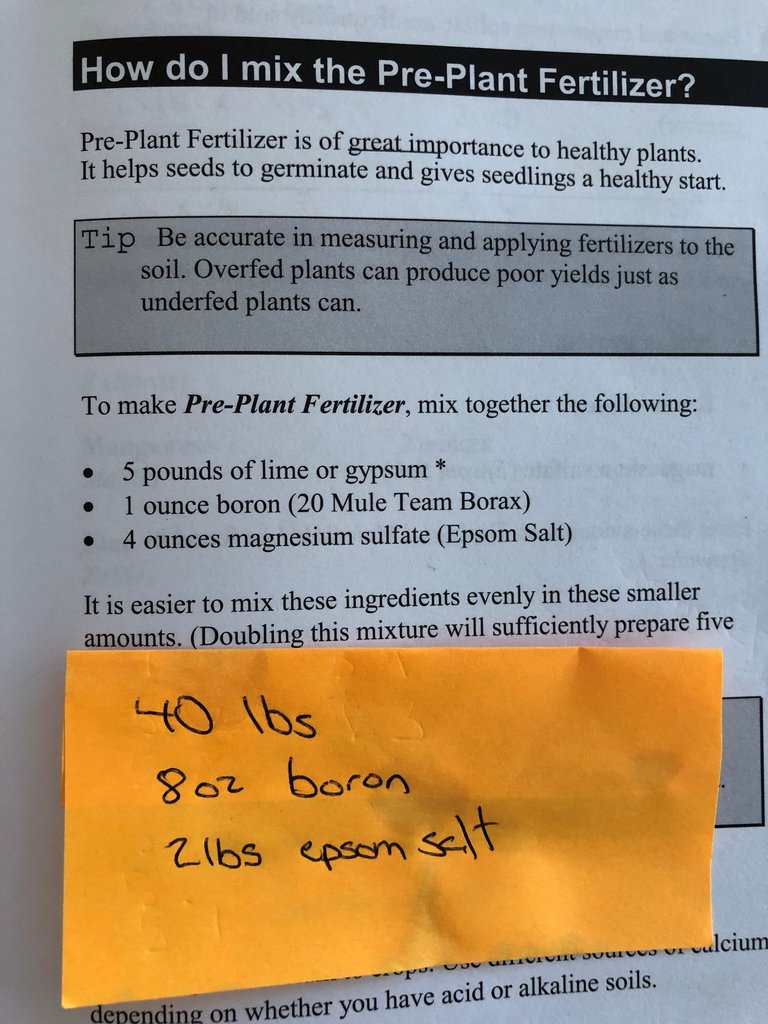In our garden we go about things a little differently than most. We don't use compost or mulch in any form. We provide all the nutrients the plants need in a small measured amount on a weekly basis. This nutrient regiment is a two part system that provides all 13 nutrients a plant needs, beyond the oxygen, carbon and hydrogen they get from the air. Those two parts are the weekly feed and the preplant. This blog post is going to cover the preplant.
Preplant is used as the name indicates, prior to planting. It provides calcium, boron and magnesium the plants require. The preplant also helps to amend your soils pH. If your soil pH is too far out of spec the nutrients in the soil can not be absorbed via osmosis into the plant. Preplant is vital to your garden for both the pH amending and calcium for the plants.
The source of the calcium in your preplant is going to be determined by your average annual rainfall. If you receive over 20 inches of rain annually you will use lime. For areas with an average below 20 inches you will need to use gypsum for your preplant.
Preplant is made with lime(or gypsum), magnesium sulfate (epsom salt) and boron (20 Mule Team borax). Typically we find our lime in 40 pound bags and mix enough preplant to use the whole bag. When the entire bag is mixed it will almost completely fill a 5 gallon bucket. You can also mix it in smaller batches, if you prefer. I will cover the mixing proportions for a small batch and a full bag next.
To mix a full batch as we do in the video you will need 40 pounds of lime or gypsum, 8 ounces of the boron, and 2 pounds of magnesium. If you prefer to do smaller batches, to 5 pounds of lime or gypsum you will add 1 ounce of boron and 4 ounces of magnesium.

We mix our preplant in a wheelbarrow and mix all the ingredients together with a chicken feed scoop. Once everything is mixed it is transferred to a 5 gallon bucket with a gamma seal lid. We have stored a full batch this way for more than 2 years as we used it in the garden with no ill effects.
You can see in our video the mixing process and hear us discuss some important information on how the magnesium and boron settles to the bottom and the need to redistribute it before use in the garden. We also cover the different forms that your lime/gypsum comes in and the "extended release" varieties.
We do have videos on our YouTube channel which outline the use of preplant and how to apply it in your garden. This post won't cover that, it is just an introduction to preplant. If you have questions I would be happy answer them for you. Happy gardening.
Congratulations, your post has been selected to be included in my weekly Sustainability Curation Digest for the Minnow Support Project.
We reached 60" of rain last year, and per my soil test from Logan Labs, the LAST thing I needed here was lime. While I did need the calcium, it was NOT in this form. My magnesium levels were too high in 2 of the gardens, so I used aragonite. The 3rd garden needed magnesium, so I used dolomitic lime, not ag lime.
For decades since 1992, because I was told our soil was acidic, so I used ag lime. This made my soil very unbalanced, as I never did a soil test until 2010. I'd strongly recommend a good soil test before adding macro nutrients.
This year I plan to get my soil tested for the first time (my gardening style so far has been "wing it.") My local cooperative extension office says it tests pH and soluble salts, but not nutrients. I'd have to send it away (and pay more) to get more info.
So is that info enough for me to get started? Or should I get the nutrients tested too?
I live in South FL, so it's logical to assume nutrients are poor. But pH is anyone's guess since it's developed land.
Yes, a good test will cost you $. I use Logan Labs and the comprehensive test is either $30 or $35, I forget. If you use Logan Labs, then you can use the worksheets to create your amendment mix I've provided in these posts:
https://steemit.com/gardening/@goldenoakfarm/reading-a-soil-test-part-1
https://steemit.com/gardening/@goldenoakfarm/how-to-read-a-soil-test-part-ii
https://steemit.com/gardening/@goldenoakfarm/how-to-read-a-soil-test-part-iii-building-the-amendment-mix
Thanks!
I'll have to go with the cheaper option this year, but I appreciate the info and hope to do something more comprehensive next year (my growing season is just beginning now that it's cooling off a bit.)
Posted using Partiko Android